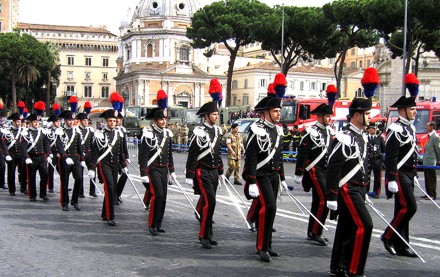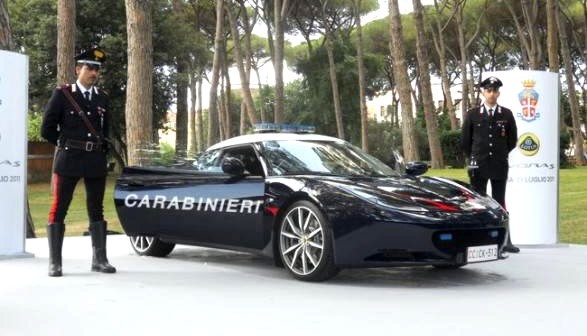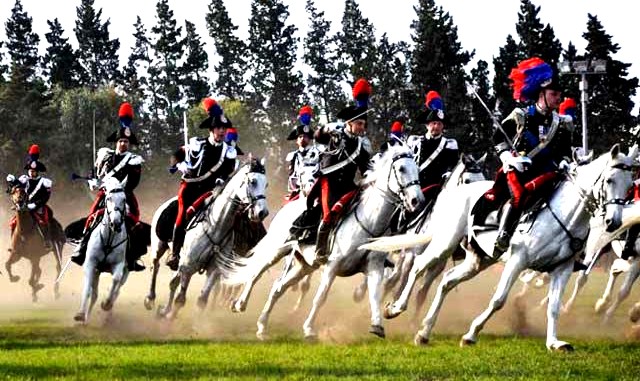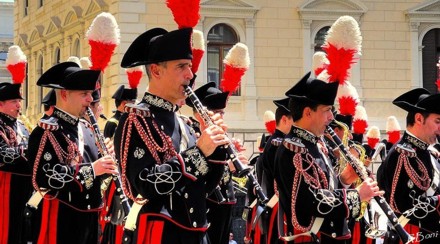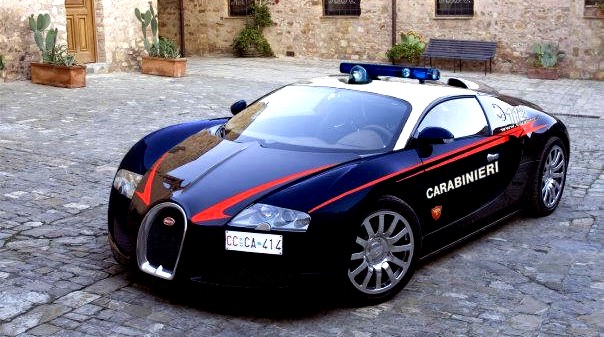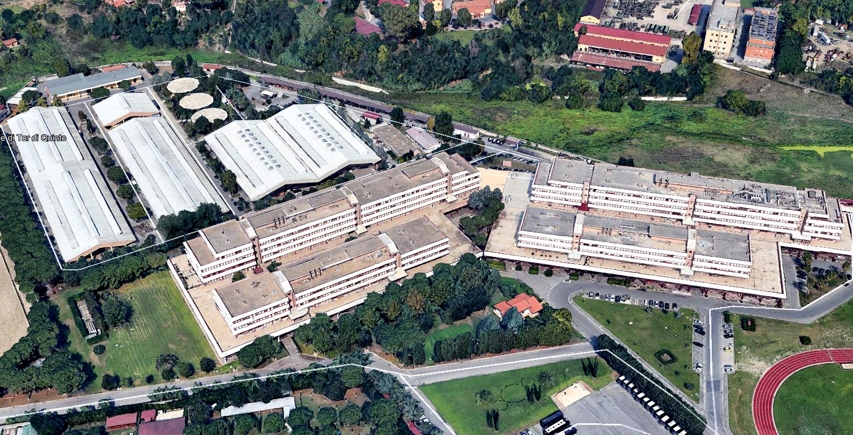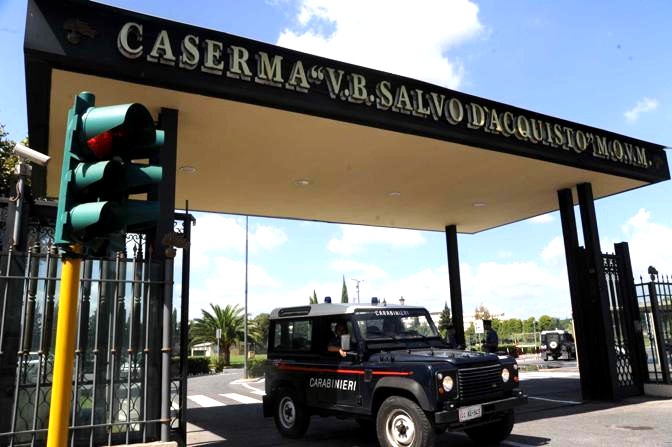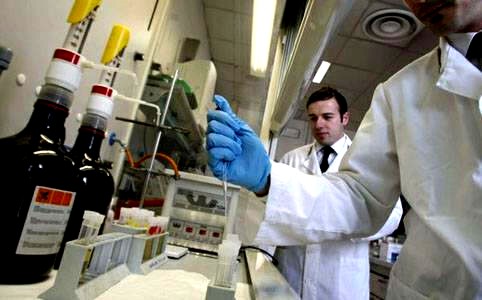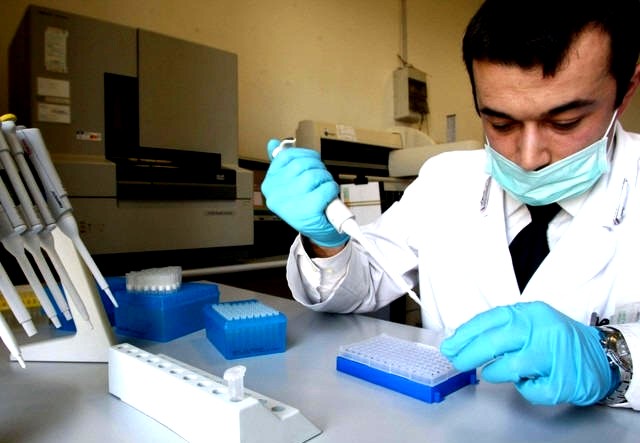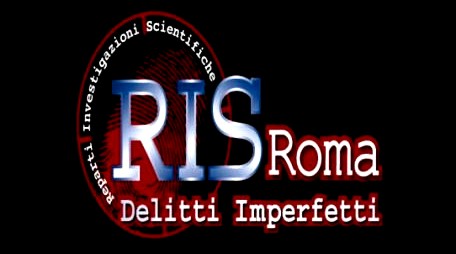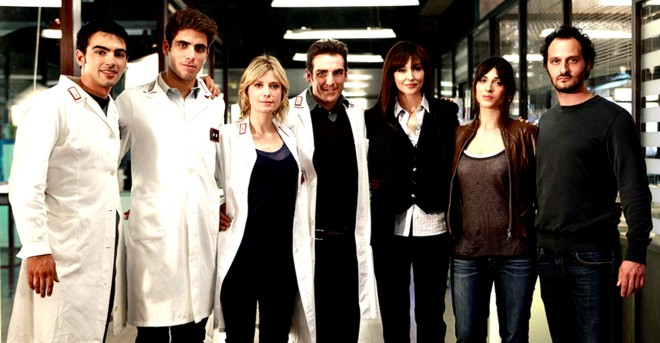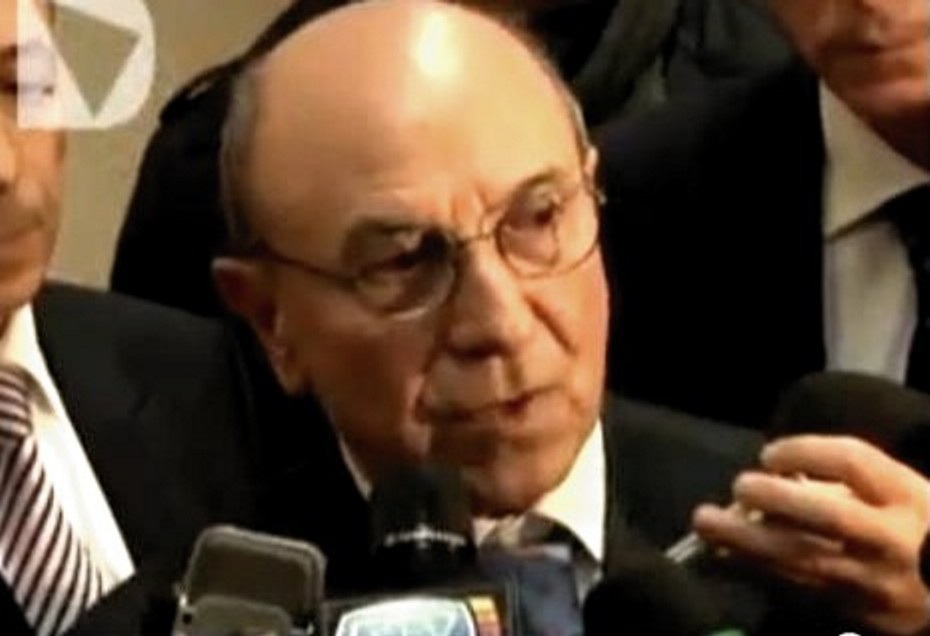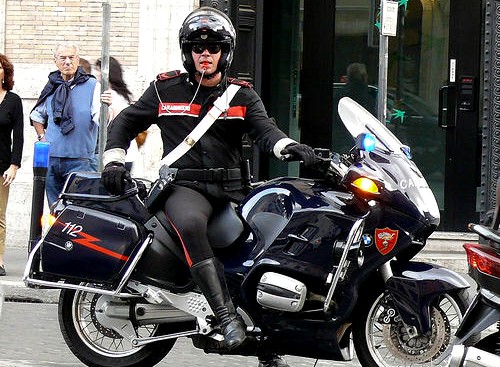
Category: Police and CSI
Sunday, April 27, 2014
Knox & Sollecito Actions In The Week Prior To Arrest: An Incriminating Behavior Pattern For Sure
Posted by James Raper
[Video above: Sollecito slams Knox’s weird behavior, while not explaining numerous examples of his own ]
1. Today’s Context To This Post
A very strong case for guilt has been made at trial and endorsed at the first-level appeal.
This series hammers home the growing hundreds of incriminating stark differences between the official evidence record, Sollecito’s and Knox’s two books, and Sollecito’s and Knox’s multiple conflicting claims since.
The focus of this post as with the one immediately below is upon the described behaviours of Knox and Sollecito, from the very beginning to this very day. This pattern has more than contributed to the certainty of their involvement in the murder of Meredith Kercher.
2. How The Behavior Speaks To Guilt
The early pointer of the staged break-in aside this behaviour gave investigators an insight into the pair’s possible involvement back on Day One: Behavioral pointers have continued on a par with corroborated developments in the case.
It has even continued, incredibly, since their release from prison. For me it is the thread that runs through this case having as much to do with the overall picture of culpability as the other elements .
This behaviour - to include what they have to say for themselves - is a catalogue of the inappropriate, of the implausible, of inconsistencies and contradictions, of evasions and obfuscations, to be gleaned from the accounts of Knox and Sollecito themselves and highlighted in the accounts of other witnesses. It is also to be gleaned from phone and computer records.
Taken together it is a formidable body of evidence which goes to character and culpability. It cannot be attributed to a railroading job, the machinations of a corrupt and evil prosecutor or character assassination by the media. It is also implausible if not impossible to explain it as being due to naivety, confusion or some quirkiness of character.
It amounts to the pair of them concocting stories, telling lies and misleading investigators and the general public.
3. Physical Evidence Array Is Already Substantial
There are numerous items of evidence which are building blocks in the prosecution case and with which we are all familiar.
- 1. The staged break-in via Filomena’s window with pointers to this outside, on the windows and shutters, and throughout the bedroom.
2. The evident partial clean up proved by footprint trails with footprints missing and what was behind the locked door.
3. Amanda Knox’s lamp on the floor behind Meredith’s locked door which she only conceded was her own at trial, under pressure.
4. Knox’s dried and congealed blood on the tap in the small bathroom that Amanda Knox and Meredith shared.
5. The bloody footprint on the mat in that bathroom definitively attributed to Sollecito rather than Guede
6. The mixed DNA of Knox and Meredith Kercher found in blood in the basin, the bidet and on the box of Q tips in that bathroom
7. Two luminol enhanced mixed traces containing DNA belonging to Knox and Meredith Kercher, one in the corridor and the other in Filomena’s room
8. Two luminol enhanced footprints of Knox in the corridor and one of Sollecito immediately outside Meredith’s room.
9. The knife taken from Sollecito’s apartment with Meredith Kercher’s DNA on the blade and Knox’s DNA on the handle and on the blade
10. Meredith Kercher’s bra clasp with Sollecito’s DNA on a hook and contamination possibilities definitively ruled out.
4. Behaviors In The First Week Of November 2007
I don’t want to make this an unduly long post. Accordingly I am going to concentrate on the period up to that famous police interrogation analysed just below. As to that critical period I will be selective but it should be enough.
The Lady With The Mop?
The story (in Knox’s e-mail) that she had visited the cottage to collect a mop, have a shower and get a change of clothing, earlier on the morning of the 2nd November, but did not notice that Filomena’s window had been broken and her room trashed is just that - a made up story. It is entirely implausible and the account unreliable for a number of reasons including-
- (a) it is hard to believe that she did not notice the hard to miss fact that the shutters to Filomena’s window were (as they were found) open - this would have alerted her to the likelihood that Filomena was back home which she would, of course, have checked out of curiosity if nothing else given that she found no one home.
(b) her claim that Filomena’s door was shut is contradicted by Sollecito who wrote (prison diary) that when he later entered the cottage with Knox Filomena’s door was wide open.
(c) it is hard to believe that she took a shower without noticing until after her shower (as she claimed) that there was blood on the bathroom mat, including a bloody footprint. In fact she didn’t even claim to notice that it was a footprint despite the fact that it was obviously so.
(d) it is hard to believe that having found the front door wide open and having found blood, and having opted for a shower and to blow dry her hair, she never got round to checking for any sign of Meredith’s presence. Any one else would have tried her door to check whether or not she was home.
(e) from her appearance at the cottage that morning it is hard to believe that she took a shower at all (let alone blow dried her hair) and the cops remarked that she reeked of body odour.
(f) less problematic but nevertheless still somewhat surprising is that as she is drying her hair she makes a fuss over shit (left by Guede) in the toilet, describes herself as being “uncomfortable” about it but does not flush it away before grabbing the mop and leaving.
The Two Stayed At Home?
The story that Knox and Sollecito had spent the previous night (the night of Meredith’s murder) indoors, critically from 9 pm onwards, that both had slept and that Knox had been the first to rise at about 10.30 am the next morning is implausible and uncorroborated, not only because this alibi is directly contradicted by the testimony of Curatolo and Quintavalle, and Sollecito’s statement to the police that Knox had gone out and not returned until about 1 am, but also in view of the following facts.
- (a) Curatolo claimed to have first seen the Knox and Sollecito in Piazza Grimana shortly after 9.30 pm but Knox claimed in her trial testimony that she and Raffaele had cooked and eaten a meal between 9.30 and 10 pm.
GCM: Can you say what time this was?
AK: umm, around, umm, we ate around 9.30 or 10, and then after we had eaten, and he was washing the dishes, well, as I said, I don’t look at the clock much, but it was around 10. And”¦he”¦umm”¦well, he was washing the dishes and, umm, the water was coming out and he was very bummed, displeased, he told me he had just had that thing repaired. He was annoyed that it had broken again. So”¦umm
LG: Yes, so you talked a bit. Then what did you do?
AK: Then we smoked a joint together”¦”¦we made love”¦..then we fell asleep.
Unfortunately Sollecito’s father himself torpedoed this dodge by telling the court that when he phoned his son at 8.42 pm Sollecito had told him that there had been a water leak while he was washing the dishes. Taking into account Knox’s testimony that they had eaten before the dish washing, this places the meal and dish washing before that call.
(b) Sollecito told the police that at about 11 pm he had received a call from his father on his land line. Not only is that not confirmed by his father but there is no log of such a call.
(c) There is no log of a call to his mobile at that time either though his father had sent a text message at that time but which Sollecito did not receive until 6. 03 am the following morning. We know that he had received it at that time because that is the time at which it is logged in the phone records. Sollecito had just turned his phone on and clearly the phone had been off when the text message was sent.
(d) There is no record of any phone activity for either of them from after the 8.42 pm call to, in Sollecito’s case, receipt of that text message at 6.03 am, and in Knox’s case her call to Meredith’s English phone at 12.07 pm the next day.
A further word about this Point (d) here as Knox has released her phone records on her web site. In her case it has to be said that this is not so unusual. Up until the 30th October there is no regular pattern of late or early morning phone activity.
It is interesting to note, however, that as of the 30th October there is a spate of texts and calls between her and a young Greek known to us as Spiros. Communication between them had in fact been going on since the beginning of October but there are 5 texts in the afternoon of the 30th, two telephone calls in the afternoon and a call at 11.38 pm on Halloween.
In the early hours of the following morning there are a couple of calls between the two. In fact we know that the two met up together for Halloween as Knox was at a loose end. Meredith had shrugged her off and Raffaele was attending a friend’s graduation dinner out of town.
Sollecito is different as his father was in the habit of calling at all hours just to find out what his son was doing and, as we know, he had called late only to find that his son’s phone was switched off.
In the case of Knox she admitted in any event that her phone had been switched off, “to save the battery”.
(e) There is no record of any activity on Sollecito’s computer after 9.15 pm and until 5.32 am the following morning when music was played for half an hour. This contradicts the claim that Sollecito had smoked pot and interacted with his computer until midnight and that they had both slept until late the following morning.
(f) The fact that the next morning, outside the cottage, both Knox and Sollecito looked utterly exhausted. This belies the alibi that they had spent a quiet night indoors and had only risen late that morning.
The Fake Call To Knox’s Mum in Seattle?
Knox falsely claims in her book that having had her shower she called her mother on her way back to Sollecito’s apartment as she was beginning to have concerns as to what she had seen at the cottage. Her mother tells her to raise her concerns with Raffaele and the other flatmates and Knox says that she then immediately called Filomena. Filomena tells her to get hold of Meredith by phone which she tries to do by calling Meredith’s English phone first, then her Italian one.
- (a) How does this correlate to the contents of her e-mail of the 11/04/07?
(b) How does this correlate to Knox’s phone records?
(c) There is no mention of a call to her mother at all in the e-mail. This from her e-mail -
“”¦.and I returned to Raffaele’s place. After we had used the mop to clean up the kitchen I told Raffaele about what I had seen in the house over breakfast. The strange blood in the bathroom, the door wide open, the shit in the toilet. He suggested I call one of my roommates, so I called Filomena”¦”¦”¦..
Filomena seemed really worried so I told her I’d call Meredith and then call her back. I called both of Meredith’s phones the English one first and last and the Italian one in between. The first time I called the English phone it rang and then sounded as if there was disturbance, but no one answered. I then called the Italian phone and it just kept ringing, no answer. I called the English phone again and this time an English voice told me the phone was out of service.”
(d) the phone records are as follows for 2 November 2007:
Ist call of the day @ 12.07.12 (to Meredith’s English phone) - 16 seconds
2nd call @ 12.08.44 (to Filomena) - 68 seconds
3rd call @ 12.11.02 (to Meredith’s Italian phone) - 3 seconds
4th call @ 12.11.54 (to Meredith’s English phone) - 4 seconds
8th call @ 12..47.23 (first call to her mother) - 88 seconds
(e) The discrepancies are numerous, see these examples:
1. The first call to her mother was not just after leaving the cottage but 40 minutes after the call to Filomena, and the call to Filomena had been placed after she had returned to Raffaele’s place and after they had used the mop and had breakfast. In fact, say about an hour after she left the cottage.
2. The first call to Meredith’s English phone was placed before the call to Filomena, and not after as Knox would have it in her e-mail. A minute before, but Knox did not mention this to Filomena, as confirmed by the e-mail and Filomena’s testimony.
3. The first call to Meredith’s English phone disappears entirely in Knox’s book.
4. The call to the Italian phone did not just keep ringing. The connection was for 3 seconds and this was followed by a connection to the English phone for 4 seconds.
5. The English phone was not switched off or out of service. Mrs Lana’s daughter had found it. She said that she would not have done so but for it ringing (the 12.07 call for 16 seconds?). She picked it up and took it into the house where it rang again (the 12.11 call - 4 seconds?). A name appeared on the screen as it rang : “Amanda”.
6. The 3 and 4 second calls are highly suspicious. The Italian phone was undoubtedly in the possession of the postal police. According to Massei it’s answering service was activated, accounting for the log. Clearly Knox did not even bother to leave a message for Meredith as it would take longer than 3 seconds just to listen to the answering service. This is not the behaviour of someone genuinely concerned about another.
- Observations:
1. In her e-mail, and repeated in her trial testimony, Knox says that she woke up around 10.30 am, grabbed a few things and walked the 5 minutes back to the cottage. If the first call to her mother was about an hour after she left the cottage (see before), then she left the cottage at about 11.47 am, which means that she spent over an hour there. Either that or she spent more (a lot more) than 20 minutes at Raffaele’s place before calling Filomena. The latter would be more likely as it is difficult to conceive that she spent over an hour at the cottage. She didn’t have the heating on when she was there. Either way there is a period of about an hour and a half between when she might have tried to contact Meredith or raise the alarm and actually doing so.
2. That we are right to be incredulous about this is borne out by the false claim in Knox”˜s book. That false claim is significant and can only be because Knox is aware of the problem and feels she needs to add some support to her implausible story of the mop/shower visit and to conceal the real reasons for the inactivity and delay connected with it.
3. That it is incredible is even belatedly acknowledged by Sollecito’s feeble but revealing attempt to distance himself from Knox in a CNN interview on the 28 Feb this year. “Certainly I asked her questions” he said. “Why did you take a shower? Why did you spend so much time there?”
4. That she makes that false claim and has constantly stonewalled and/or misplaced the 16 second call to Meredith’s English phone is indicative of her guilty knowledge. Her guilty knowledge with respect to the 16 second call was that it was made to ascertain whether or not the phones had been located before she called Filomena, and hence for her it was not (incredulous though this is without such explanation) a pertinent fact for her to bring up with Filomena.
The Real Call To Knox’s Mum In Seattle?
As to the 12.47 call to her mother itself (4.47 am Seattle time and prior to the discovery of Meredith”˜s body) Knox not only did not mention that in her e-mail but in her trial testimony she steadfastly declined to recall that it had occurred.
She clearly did not want, or could not be trusted, to discuss why the call had occurred and what had transpired in conversation with her mother before the discovery of Meredith’s body.
Not only was the timing of the 12.47 call inconvenient to her mother but I found it interesting to note from Knox’s phone records (covering 2nd Oct - 3rd November) that mother and daughter do not appear to have called or texted each other once up until that 12.47 call.
It would appear then that in so far as they remained in direct communication with each other for that period it must have been by e-mail. One can therefore imagine that her mother was very surprised to receive that call.
It is also very difficult to accept that Knox could not recall a phone call she was not in the habit of making. (On the other hand the same records show that it was not at all unusual for Knox and Meredith to communicate with other on Meredith’s English phone.)
Sollecito’s Call From His Dad?
At the cottage, and prior to the above call, Sollecito received a call from his father at 12.40 am. Do we know what they discussed? It would in any event have been after the discovery of Filomena’s broken window and (allegedly) Sollecito’s (rather feeble) attempt to beak down Meredith’s door.
Did the responsible adult advise his son to do the obvious and call the police? One would think so, but then why was there a 10 minute delay before he called his sister in the Carabinieri at 12.50 am? Indeed, why call his sister at all? Filomena had also urged Knox to call the police when she called at 12.35.The delay might be explained by the unexpected arrival of the postal police and if this was the case then it was before Sollecito called the 112 emergency services.
The Claims Of Finding Meredith’s Body?
Neither Knox nor Sollecito saw into Meredith’s room when the door was broken down and her body discovered on the floor under a quilt. Yet in the immediate aftermath it is as if they have wanted others to believe that it was they who discovered her body and in the bragging about this there have been disclosures, not only as to what they should not have been aware but also suggestive of disturbed personalities. This behaviour was remarkable for all the wrong reasons.
- (a) Luca Altieri”˜s testimony makes it clear that Knox and Sollecito had heard about Meredith”˜s cut throat directly from him during the car ride to the police station.
However her bizarre and grotesque allusion in the early moments of the investigation to the body being found stuffed into the closet (wardrobe) is not just factually incorrect (it was lying to the side of the closet) but bears correlation to the later forensic findings based on blood splatter in front of and on the closet door, that Meredith had been thrust up against the closet after having been stabbed in the throat.
(b) The behaviour of Knox and Sollecito at the police station is documented in the testimony of Meredith’s English girlfriends and of the police. Whilst it is true that people react to grief in different ways it is difficult to ascribe grief to Knox’s behaviour. Emotionally she was cold towards Meredith’s friends and occasionally went out of her way to upset them with barbed and callous remarks.
The fact that Knox was not observed to cry and wanted to talk about what had happened is not of itself indicative of anything but remarks like “What the fuck do you think, she bled to death” and her kissing and canoodling with Raffaele (including them making smacking noises with their lips when they blew kisses to each other) in front of the others was not normal.
Rather chilling in retrospect was a scene between the pair of them when Knox found the word “minaccia” ( in english - threat) amusing and made a play of it with Sollecito in front of witnesses.
(c) Grief is in any event reserved for friends and relations, or people one much admires. The evidence is that the initial short friendship between the two had cooled to the extent that Meredith was studiously, if politely, avoiding being around Knox. For the narcissistic and attention seeking american girl this would have been difficult to ignore and may well have offended her.
(d) The next day Sollecito was willingly collared by a reporter from the Sunday Mirror and told her about the horror of finding the body.
“Yes I knew her. I found her body.”
“It is something I never hope to see again,” he said. “There was blood everywhere and I couldn’t take it all in.”
“My girlfriend was her flatmate and she was crying and screaming, ‘How could anyone do this?’”
Sollecito went on to tell the reporter that “It was a normal night. Meredith had gone out with one of her English friends and Amanda and I went to party with one of my friends. The next day, around lunchtime, Amanda went back to their apartment to have a shower.”
About the only thing that is true here is that he knew Meredith.
Wednesday, November 06, 2013
Appeal Session #3: The Carabinieri Labs Report On The DNA On The Knife
Posted by Our Main Posters
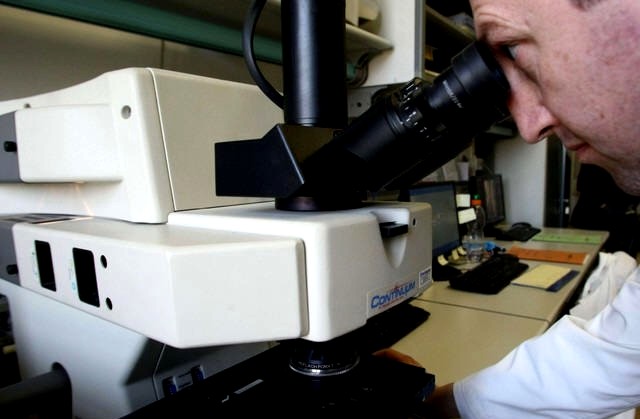
[Above: an image of similar testing in the same Carabinieri laboratory in north Rome]
Final Update
So the court session does not even extend beyond the lunch hour. Good morning Seattle! At this moment it is still only 3:30 in the morning there. Only night owls will know what happened.
Yummi and Mason2 may have more for us, which will appear either here below this final update on in Comments. Also Andrea Vogt and hopefully Barbie Nadeau will be filing longer reports in English. We will also check out all the Italian reporting.
Hard to see any game changers in today’s strong but undramatic testimony. The Carabinieri RIS DNA experts could not be shaken. All momentum remains with the prosecution and with the Supreme Court’s “givens” on the evidence, such as the presence of three attackers in Meredith’s room.
The defenses seem to be giving up. They could have phoned it in. Sollecito lawyer Bongiorno didnt make any new fuss. And Amanda Knox lawyer Dalla Vedova was cut off by the lead judge several times, for trickily going off the point. He really is out of his depth in a criminal trial; at the same time often condescending.
And a seeming big slap in the face for the American defense stooge Greg Hampikian who seems to have illegally colluded with the disgraced Hellmann consultants Conti and Vecchiotti (who were not even mentioned today) when Judge Nencini asked Dr Barni “Would you be able to provide reliable standards without using suggestions from Americans?” Dr Barni responded “Of course”.
And Sollecito “wasted” his statement by whining about his life, showing no compassion for Meredith (despite his claimed visit to her grave), and not answering any of the dozens of open questions. Sollecito really needed to show he is both strong and compassionate and NOT a weakling under the thumb of Amanda - but he seems to have done quite the opposite. The family lawyer must not be too pleased.
Fifth Update
The opening of Frank Sforza’s trial in the same courthouse is postponed, apparently because new information on his campaign to poison opinion against the judiciary and his unsavory connections has been coming in.
Information will be exchanged that is gathered at this trial on mafiosos Luciano Aviello and at Aviello’s own trial for obstruction of justice which is now proceeding in the same Florence courthouse in parallel.
The findings and possible charges on the defamatory and dishonest books by Knox and Sollecito are due about now from the Florence and Bergamo prosecutors. Information gathered in those investigations could also be fed in to this process, or put aside for separate trials.
As both the AK and RS books are bulging with the standard PR talking points (some of which flowed from Frank Sforza and Doug Preston) in a sense it will be Curt Knox, the Mellases, Marriott, Sforza, Fischer and Moore who will be put under the microscope.
Fourth Update
A more detailed report on the DNA phase today from the Andrea Vogt website.
The RIS Wednesday deposited their forensic report on trace 36i, a spot of DNA identified (but not earlier tested) on the kitchen knife alleged to be the murder weapon. “Cento Percento” (100 percent) said Major Berti, discussing compatibility. The RIS found that the DNA was compatible with Amanda Knox, and excluded that it was that of Sollecito, Guede or Kercher.
The RIS expert was asked only a few questions from attorneys and the judge. The judge asked why the RIS had done two amplications of the DNA and not 3 or 4. Major Berti described that two is considered the minimum number of amplifications necessary, according to today’s forensic standards, doing less (or more) might have diminished the reliability of the results. The judge also asked about the age of the equipment used. Berti responded that the forensic kit used this time has been commercialized since 2010 and available for use since 2011.
At one point the judge stopped a line of questioning by Knox’s Rome attorney Carlo Dalla Vedova, who was asking why the RIS described Knox’s DNA as “fluids” when a prior expert had said the trace did not come from blood. Nencini said: That question was not put to the RIS by this court, it was not their job to determine that. The other experts’ reports are in the case files for everyone to read, he noted, adding: “We cannot put words in the mouth of this expert that were said by another expert.”
Third Update
Tweets from our main poster Yummi (Machiavelli)
32. Judge Nencini’s comments were always addressed at Dalla Vedova’s arguments, who was in fact a bit silly
31. The Judge declared the evidence phase closed. Next court dates are 25 November for prosecution argument and 26 for the defences with 16 and 17 December.
30. Judge Nencini asked Dr Barni “would you be able to provide reliable standards without using suggestions from Americans?” Dr Barni: “of course”
29. Dalla Vedova said Tagliabracci was the only Italian source in the RIS report, all others are foreigners, emphasized the American labs…
28. Sollecito said his family absolutely never had issues with justice. And he is a proud ‘member’ of that family
27. He also played the ‘national’ card, as he remphasized ‘I am Italian’ twice and then addressed the court ‘I am an Italian, as you are’
26. Sollecito mentioned the defens’s arguments (he has an orthopedical issue with his foot etc.).
25. The questions of all parties to the experts were intended to elicit information to be used in arguing the unrelated previous finding
24. He mentioned Meredith’s name only once, to say he barely knew her.
23. Sollecito talked with a faint voice, a long speech in which he described himself as a victim.
22. The Carabinieri say that there are only a few governmental laboratories which have the 17025 certificate (the Carabinieri and the Police)
21. Nencini stops Dalla Vedova, points out that scientific community is international
20. Dalla Vedova tries to elicit that the good standards are not the Italian ones.
19. The RIS obtained the ISO9001 certificate in 2008, and a more specific certificate in 2012.
18. Bongiorno asks RIS to explain why two amplifications are recommended.
17. Prosecutor Crini asks if there are criteria to distinguish which labs or which experts are more competent.
16. Speaking about their software which allows to weight probabilities of attribution.
15. They note that three alleles which are ‘alien’ were drop off in one duplicate.
14. The biologic method has a ‘consensus’ interpretation and a ‘composite’ interpretation, two ways to interpret the double result.
13. They describe the methods employed, the ‘biologic’ method and the ‘statistic’ method.
12. Absence of any male trace stands out as a feature of the sample (all contributors are females)
11. They extracted two profiles in a duplicate in agreement with experts of all parties
10. Dr Berti says the sample was a low template. They have a strategy to obtain reliable results.
9. Points out that documentation says sample 36i comes from insertion of blade in the handle.
8. Dr. Berti summarizes the recovery of sample in Vecchiotti’s lab.
7. Bongiorno says Sollecito intends to release a spontaneous declaration. He will do that after the experts testimony.
6. Berti and Barni enter the court.
5. Many law students from the Florence school for Magistrates are in court to follow the hearing.
4. Sollecito had managed to enter the courtroom from side entrance eluding photographers. Carlo Torre arrives in court.
3. Giulia Bongiorno & Raff kiss each other. Giulia, Raff & Father have a worried discussion
2. I wonder… will the court withdraw his passport?
1. Raffaele Sollecito is in courtroom. Walking in empty room, few people waiting. Hearing will start 1/2h probably
Second Update
Tweets from Patricia Thomas (AP) and Sabina Castelfranco (AP)
Patricia Thomas “@MozzarellaMamma: RaffaeleSollecito - Amanda Knox and I were very carefree and isolated in our love nest.
Sabina Castelfranco “@SCastelfranco: Sollecito says he is not the assassin he has been described as. Says Amanda was his first love
Patricia Thomas “@MozzarellaMamma: RaffaeleSollecito - I have been described as an assassin. Amanda Knox was my first real love in life
Patricia Thomas “@MozzarellaMamma: RaffaeleSollecito takes stand to make statement, starts complaining about media descriptions of himself
First Update
Tweets from Barbie Nadeau
35. Nov 25 - prosecution; 26 - civil; Dec 16 - Sollectio; 17 - Knox; Jan 9 - rebuttals, 10 deliberation and verdict
34. Dec. 16, 17 closing arguments for Knox and Sollecito
33. Judge closes hearing for day, says closing arguments begin Nov 25, 26, must find December dates to conclude
32. Sollecito finishes by thanking judges for their time, judge tells him he can intervene any time during rest of appeal until they deliberate
31. Sollecito says he hates the fame, how it has hurt him, how it isn’t fair
20. Sollecito says he has a difficult time looking for work, people associate him with the murder of meredith kercher
29. Sollecito says that even on his vacation in Dominican Republic, he had to defend himself like a public figure, his life is judged by all
28. Sollecito repeats twice that he never met Rudy Guede, how nothing in original trial was based on reality.
27. Sollecito takes trip down memory lane, highlights worst parts of trial and incarceration for him, has not mentioned meredith kercher yet
26. RaffaeleSollecito - I feel a persecution. It is a nightmare, beyond all imagination.
25. RaffaeleSollecito—close to tears as he testifies to court “I am fighting every day to bring out the truth”
24. Jury totally transfixed by sollecito declaration, can’t take their eyes off him
23. Sollecito thanks and defends his family, calls amand knox his first love
22. Judge asks for Sollecito declaration now
21. Judge asks about relevance of kit they used, how old technology was, etc.
20. Judge asks what minimum testing is for validation of DNA, RIS says “at least two”
19. Judge tells Dallavedova he cannot put words in mouth of new expert that were said by previous experts, this is fresh analysis
18. Judge clarifies that RIS was not asked to reanalyze work that has been done, but to test a sample that has not been tested.
17. Dallavedova essentially kicks goal into own net, not doing amanda knox any favors by making RIS defend methods used in original conviction
16. Dallavedova manages to get RIS expert to defend Italian methods, says they are in line with global standards, this was crux of 1st appeal
15. DallaVedova asks about international protocol, backfires slightly b/c RIS expert says he doesn’t want to dis italian methods, are valid too
14. Bongiorno hammers point that international standards in DNA must be followed ([claims]they were not for meredithkercher sample on tip of knife)
13. Jury in new appeal trial for amanda knox; sollecito look totally lost, lots of daydreaming during DNA testimony, nail biting, looking around
12. Bongiorno asks RIS expert specifics of amplification of sample with an eye to trace with meredith kercher DNA that was amplified many times
11. Prosecutor asking for clarification on how samples are tested, how RIS experts are qualified, etc.
10. RIS: DNA testing as important to exclude suspects as to confirm them, in this case no question that amandaknox DNA is on knife, others’ not
9. RIS: testifying about international standards necessary to validate DNA, how they used in their examination of this particular spot on knife
8. Sollecito listening attentively and jotting notes as RIS expert testifies about the knife
7. RIS: the spot they tested on the knife (near handle) matched definitively the DNA of amandaknox in double tests
6. RIS: the spot they tested on the knife did not match meredith kercher or rudy guede or sollecito after double testing
5. RIS: Experts tested spot “H” [?] on the knife (the spot near the handle) for both the victim meredith kercher and suspect
4. RIS: DNA analysis showed no x chromosome, i.e.: no male chromosome in sample they tested on knife
3. RIS: essential in DNA testing to double test samples to validate results
2. RIS expert: explains technical details of testing DNA, how much is needed, how it is tested
1. Judge says he wants to hear from RIS experts first and then sollecito can give his declaration
Initial Post
Well, that first shot from the court at the top sure is a surprise, and maybe bad news for Amanda Knox. Where are Sollecito’s other lawyers, Bongiorno and Maori? Presumably they are off to the side talking. .
In tweets Andrea Vogt has mentioned that she is reporting for the BBC and the Associated Press TV; reporters cannot have bigger clients or more global reach than with those two. This is from Andrea Vogt’s website.
Court is now in session. Day will begin with RIS forensic debates. Raffaele Sollecito will make a statement later in the day.
Sollecito arrived in the Florence court of appeals looking relaxed and ready to make his case before the court later in the day. His father, Francesco Sollecito, also appeared visibly happy to have his son back in arms reach, after an extended stay in the Caribbean. A large number of his friends were in the audience.
Forensic experts for the defense Walter Patumi, Carlo Torre and Sarah Gino were also in attendance in preparation for debate on the new DNA evidence tested by the RIS in Rome, specifically, trace 36i on the kitchen knife alleged to be the murder weapon. RIS say the DNA profile is that of Amanda Knox. Arguments today will mostly about how it might have gotten there, with prosecutors attempting to place it in the context of the murder and defense attorneys arguing it could have been transferred during normal domestic use of the utensil.
Next hearings are Nov. 25-26, with a verdict expected in mid-December.
Thursday, October 31, 2013
Why DNA Test Results 6 November May Leave No Further Argument Over Knox And Sollecito Guilt
Posted by Peter Quennell

[Above: an image of similar testing in the same Carabinieri laboratory in north Rome]
The official results of the tests by the Carabinieri laboratory will be made public by Judge Nencini in court on 6 November.
The report and attachments are reported to be more than 100 pages long. Andrea Vogt has already warned that no assumptions should be made yet that we know the full story. But already for the defenses, matters do not look pretty.
- 1) It sounds like the result of the DNA near the top of the blade (see images below) shows conclusively that it is another sample of Knox’s DNA. Given where the sample came from it could be blood DNA and add further proof to the notion that Knox was injured while struggling with Meredith.
2) The low-copy-number amplification technique used was almost identical to that used by Dr Stefanoni to prove that it was Meredith’s DNA on the blade of the knife - actually that was a larger sample. Judge Massei’s court accepted this, Judge Hellmann’s consultants tried very hard to undermine it, and the Supreme Court ruled that they did not even come close.
Earlier this year, our main poster Fly By Night in a post worth re-reading explained just how conclusively the results of that first testing pointed to both Meredith and Knox.
As is typical of all DNA analyses, Stefanoni proceeded to amplify the results to a point where an electropherogram would reveal meaningful “peaks” and found that a resultant 13 pairs of peaks corresponded precisely to peaks derived from a known sample of Meredith Kercher’s DNA!
In this case it is pointless to attempt to argue that Stefanoni somehow exceeded the amplification limits of her equipment. As outlined in the DNA discussion above, the typical problems associated with an amplification of low levels of DNA are related to peak imbalances, enhanced stutter, allele drop-outs, or allele drop-ins.
In this case there was nothing but a perfect match for Meredith that even Carla Vecchiotti and Stefano Conti could not deny in court.
Stefanoni had clearly identified an identical match for Meredith’s DNA on the blade of Sollecito’s kitchen knife, leaving Vecchiotti and Conti no other option than to argue for “contamination” in court.
However, it was convincingly demonstrated by Stefanoni and all evidence handlers that from knife collection through laboratory analysis no reasonable opportunity for contamination with Meredith’s DNA existed.
Dr Stefanoni’s testing of all the DNA from the crime scene was done in front of some defense observers. Those who were there saw her do nothing wrong. Dr. Patrizia Stefanoni, Dr. Renato Biondo, Professor Giuesppe Novelli, Professor Francesca Torricelli, Luciano Garofano, Elizabeth Johnson and Greg Hampikian have all confirmed that Meredith’s DNA was on the blade of the knife.
It looks as if the prosecution has now achieved a clean sweep of all of the of DNA testing. Meredith’s DNA on the lower blade of the knife seems even more conclusively a firm given, and so does Knox’s on the upper blade and the handle.
We are where we were back in 2008 before trial, where other defense lawyers might have suggested to their clients to select a trial of the short form type - the same choice that will see a somewhat penitent Guede out on work release in two years, no more.
But instead, their clients could now be facing life sentences for that bad choice.
Image: looking along the blade toward the handle, both sides of the knife
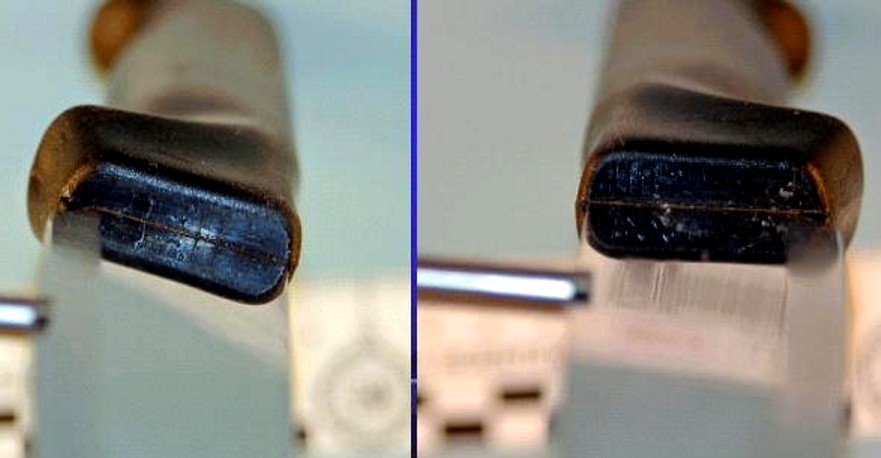
Here is an image showing the I trace in the location described in the post with credit to Iodine of PMF and the Case Wiki
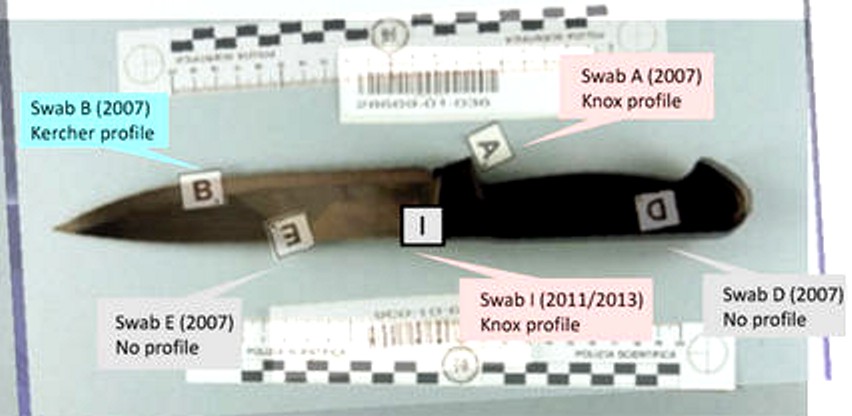
Monday, October 14, 2013
Carabineri Labs Might Prove Fourth And Conclusive Scenario For The Mixed DNA Samples In The House
Posted by Peter Quennell
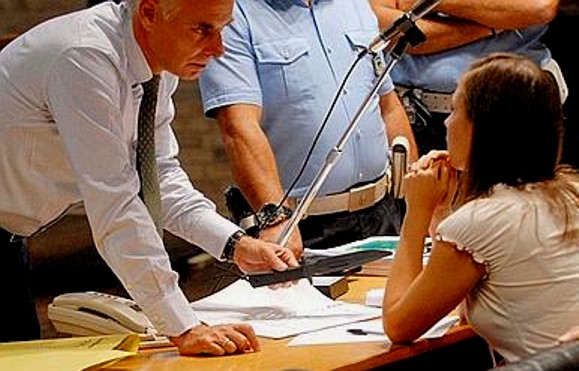
Lab work is believed to have continued today in the absence of the defense observers, and will continue on and off through to October 30th.
The defense observers may not have a further role at the laboratory. Most or all of the analysis leading to firm attributions of the DNA will be done by the Carabinieri team electronically.
It is that final attribution that the defenses are widely rumored to be so terrified of. That Knox’s DNA is there seems a given. The cliffhanger is whether Meredith’s DNA is there also.
Another possible mixed trace. If so it would be the sixth one.
Judge Massei did not arrive at a full scenario for how the five mixed blood traces at the crime scene could have been created. He described what was found by crime scene investigators and moved on.
After the 2009 Massei trial some further analysis was conducted.
With great help from Luciano Garofano’s DNA chapter in Darkness Descending and Barbie Nadeau’s and Andrea Vogt’s excellent reporting, we posted a comprehensive update mid-2011.
The locations of the five mixed traces at the crime scene are as follows.
1. Bathroom near Meredith’s room:
- On the drain of the bidet
- On the Q-tip box located at the ledge of the sink
- On the edge of the sink
Elsewhere in the apartment:
- In a luminol-enhanced bare footprint in the hallway outside Kercher’s room
- In a luminol-enhanced spot found in Filomena Romanelli’s room
Three sources for Knox’s blood have long been suggested: some bleeding from her ear, some bleeding from a possible nosebleed, some bleeding from the open scrape on her neck. .
All three of them could theoretically have been inflicted by Meredith as she struggled with the trio to save her life. None seem to explain why there were repeated MIXED traces.
That has remained a huge puzzle. But now we are looking at a fourth scenario: that Knox cut her hand with the top end of the blade as she stabbed at Meredith’s neck.
That could explain once and for all where Amanda Knox’s blood came from AND why it was mixed with Meredith’s blood. It happened right there.
[Click for larger image. Handle as from the blade direction. Sample is apparently from gap on sharp side.]

Friday, October 11, 2013
The Carabinieri Laboratories In North-Central Rome Where Now Two Different Samples Need Attribution
Posted by Peter Quennell
Third update
Italy-based freelance reporter Andrea Vogt has tweeted the following: Leaks suggest DNA on knife shows knox genetic profile, but there is another profile being studied. Too early to interpret
Second update
Excellent comment on PMF by the poster Hugo which explains how the balance hasn’t changed.
The song remains the same. The republic contends that Amanda Knox used that knife to murder Meredith Kercher. The knife has yielded the DNA of just two people: Knox, in a position which indicates that she was gripping it, and Meredith, in a position which indicates that she was stabbed with it.
The defence can easily claim that Knox’s trace results from normal culinary use (although Stefanoni said the handprint indicated an atypical stabbing grip, with the knuckles on the same side as the blunt edge of the blade, and not a normal culinary cutting grip, with the knuckles on the same side as the sharp edge).
The problem is Meredith’s DNA at the sharp end. ‘Independent court-appointed expert’ Carla Vecchiotti admitted on the stand that this could not have arisen from laboratory contamination.
Professor Christopher Halkides’ suggestion that the contamination occurred during collection, because Stefano Gubbiotti acquired Meredith’s ‘aerosol DNA’ on his clothing, when he was supposedly in the house the same day, almost a week after the murder, and thus transferred the DNA from his clothing to his fingers to his evidence-handling gloves to the knife when he took it from Finzi’s envelope and re-packaged it in a stationery box at the Questura, is self-evidently absurd, fanciful, fictional and completely outwith the realms of actual forensic science.
And it’s not in evidence anyway, so it’s not an option open to the court.
Plus the objection to low copy number DNA is an American superstition not recognised in Europe. Unusually, it’s a scientific area where the US lags well behind. So you get hillbillies like Bruce Budowle grumbling, ‘Cain’t rightly say what that there newfangled LCN is, but ah reckon ah’m agin it.’ You’ll recall that a British appeal court has found that Bruce Budowle hasn’t the faintest idea what he’s talking about and also that, like Halkides, he tends to cite sources that don’t actually say what he says they say.
Knox is there on the hilt of the knife. And M is there near the point of the blade, and she’s trying to tell us something.
First update
The gap between the blade and handle of the knife was apparently widened to obtain the sample for the test. Sollecito lawyer Maori has claimed it is Amanda Knox’s. It is apparently adjacent to her previous trace.
If that is the case, the strength of the DNA evidence (which is very strong) remains unchanged. Dr Stefanoni identified Exhibit 36 on the blade as a strong trace of Merediith’s DNA. This was supported by various experts.
No contamination of that trace has ever been proved - or even a convincing contamination scenario put forward - and the video on top of the post below shows how the DNA charts for the sample and for Meredith totally match.
First post
Human DNA is widely reported in Italy to have been established from the sample never before tested on the large knife.
We may have to wait on an announcement from Judge Nencini in Florence as to whose DNA it is. That may not happen today.
These labs in the Carabinieri barracks are not far from the center of Rome. They are very well know to Italians because (images at bottom) “RIS” the Italian version of the show “CSI” is set there.
Thursday, October 10, 2013
Testing Of The DNA Sample Starts Today Though Possibly No Results Announced Before 6 November
Posted by Peter Quennell
1. ViaDellaPergola’s video
That video from 2010 illustrates how the existing positive tests described in the Massei Report were crystal-clear; subsequently Hellmann, Zanetti, Conti and Vecchiotti (all now being investigated) so muddied the water.
2. From our short-form Massei Report
This is from Part Three of the four-part abbreviation of the Massei Report done by Skeptical Bystander and a PMF team in mid-2011.
Exhibit 36: The double DNA Knife
Exhibit 36 is a 31 cm long knife with a 17 cm blade and a dark handle. It was seized from the kitchen cutlery drawer at Raffaele Sollecito’s home, located at 110 Corso Garibaldi in Perugia, on 6 November, 2007 when Chief Inspector Armando Finzi was ordered to perform a search of Sollecito’s residence. This exhibit is important because “Sample 36b” taken from a scratch on the knife blade yielded Meredith Kercher’s biological profile.
After putting on gloves and shoe coverings, Finzi and his team entered the home. They noted a strong smell of bleach. Opening the cutlery drawer, they saw a big, “extremely clean” knife. In Sollecito’s bedroom they found a second knife. The knives were bagged and sealed.[106]
Exhibit 36 was carried back to the police station, where it was placed in a box for shipping to the Polizia Scientifica in Rome. Dr. Stefanoni was the recipient of the box containing the knife in Rome. All parties testified that standard procedures were followed to avoid the risk of contamination.
On 4 November, 2007, Meredith’s roommates Filomena Romanelli, Laura Mezzetti, and Amanda Knox had been taken by the police to look at the knives in their kitchen at the apartment in Via della Pergola. Personnel from the Questura reported Amanda’s “severe and intense emotional crisis, unlike [the reaction of] the other two girls”.[292] This behavior was contrasted to Amanda’s behavior at Police headquarters two days earlier:
“This circumstance appears significant both in its own right and also when one considers that Amanda had never previously shown signs of any particular distress and emotional involvement (in the Police headquarters, on the afternoon of November 2, Meredith’s English girlfriends, Robyn Carmel and Amy Frost in particular, according to their declarations, had been surprised by the behaviour of Amanda, who did not show emotions).”[292]
Investigators’ attention was alerted to the Exhibit 36 knife because of Amanda’s inconsistent behavior. Later, police overheard a jail conversation between Knox and her parents on 17 November, when Knox said, “I am very, I am very worried about this thing with the knife ... because there is a knife of Raffaele’s ...”.[292]
Exhibit 36 thus became a central piece of trial evidence. The debate would subsequently be focused on two issues: The compatibility of the knife with the large stab wound in Meredith’s neck; and the reliability of the DNA analysis.
Considering the first of these points, although the knife blade is 17 cm long, the depth of the larger wound is just 8 cm . This “discrepancy” was the basis of defense efforts to discredit the knife as a murder weapon. The compatibility of the Exhibit 36 knife and the larger of Kercher’s wounds is addressed by Professor Bacci (see p. 121 of the Massei report). Professor Norelli maintains that “it is not said that a blade is always embedded (plunged into) the target right up to the handle; the blade may also go (in) only to a certain portion of its length, and not right up to its end”.[126]
It is noted that the movements of the victim may have played a part in determining the depth of the cuts. “If I insert a centimeter of the blade into the victim and the victim suddenly moves towards me, how much of the blade will be driven inside the body surface area is absolutely unpredictable and depends on the action of both”.[129] Alternatively, the blade of the knife might have met an obstacle. The cutting action is described on p. 146 and again starting on p. 152.
Defense witness Dr. Patumi disputed the compatibility of the wounds with said knife, arguing that a blade of 17 cm length could not have caused a cut 8 cm deep; see p. 156-157. However, the Court rejected “the thesis of the incompatibility of the most serious wound and the knife Exhibit 36”, holding this thesis to be “unacceptable” .[172]
Regarding the second point ““ that of the DNA analysis ““ Dr. Stefanoni was the responsible expert at the crime lab in Rome. Although no biological traces were visible to the naked eye on the face of knife blade, Dr. Stefanoni perceived scratches - “anomalies in the metal’ - on the blade when rotating the blade under strong lighting. The streaks were:
“... visible under good lighting by changing the angle at which the light hit the blade, since obviously the blade reflects light and thus creates shadows, making imperfections visible.”[196]
Sample 36b was taken from one of these points on the blade. The genetic profile of Meredith Kercher was identified from this sample. Stefanoni presented charts to the court, showing the DNA profile: she noted “that the peaks were a bit low, but that without doubt were still within the range that is considered useful for testing a specimen (page 108). Although of a much lower quantity of DNA, the profiles were nonetheless very present and, by making a comparison with Meredith’s profile, Dr. Torricelli reported that “šwe find all the alleles, and we find them to be equal to those obtained from the swab taken, from the sample taken from the wound. Therefore in this case too, without doubt”› -she continued- “šalthough we are confronted with a sample that contains very little DNA, it nonetheless contains the DNA of only one person and is therefore comparable to Meredith’s; with regard to this knife, I would say I have no doubt in interpreting it: specimen A with Amanda’s profile and specimen B with the profile, compatible with that of Meredith.”[231-32] However, the amount of DNA was small and it was all used up in order to run a single test.
The defense objected that it was impossible to evaluate whether the actual nature of Sample 36b specimen:
“.. when we have a small amount of DNA we talk about low copy number DNA, and that when this type of DNA is present, we are indeed able to carry out our amplification and obtain a profile, but we must remember that we may have lost one of the alleles, we may have an allelic imbalance ... it becomes very difficult to distinguish from a real allele, so that when working on ... small quantities of genetic material, it is necessary to be very cautious in interpreting the results.”[237]
To this point, Dr. Stefanoni argued that it is preferable “to know to whom a biological specimen is attributable, rather than ascertaining the nature of that specimen, without attributing it to anyone.”[288]
Furthermore, it was argued by the defense that the quantity of DNA was too low to be able to perform the tests and consider the results reliable. Given a low amount of DNA, the risk of contamination is high - particularly given the very numerous number of samples being analyzed.
The court rejected the possibility of contamination because no anomalies were ever identified in the Polizia Scientifica’s analytical process. The Prosecutor pointed out that all tests had been carried out in the presence of a lawyer/consultant for the defense - who had raised no objections during the testing. The possibility of contamination during the collection of evidence was rejected based on a detailed consideration of the collection process.
Thus, the DNA from Meredith which was found on that knife cannot be traced back to any contamination occurring in the house in which it was found, or to the method of acquisition of the knife on the part of Finzi, or even to the collection and dispatch methods used by Gubbiotti. In addition, as has been said, that such contamination could have been carried out by the laboratory is also ruled out.[266]
In addition, Dr. Stefanoni testified that she did have the biological profile of the defendants, but did not employ them while interpreting the electrophoresis diagrams. Nevertheless, the Massei report judges that:
“... the main criticisms advanced by the defense concerned precisely this very small DNA quantity, and it raised the question of the reliability of the result obtained.”[288]
To this central point, Dr. Stefanoni:
“Regarding the too low quantity of DNA, Dr. Stefanoni declared, as has been seen, that even in the case of a particularly scanty amount of material, the analysis and evaluation should be performed, and she added that, if the data that emerges is absolutely readable and interpretable and the correct laboratory practice was followed, the result is reliable and there is no reason to repeat the test.
“It does not follow ... that the data is unusable and unreliable as a consequence of a lack of repetition due to a lack of further quantities of DNA. It is necessary, instead, to take account of the data that emerges from such a specimen and to check for the ““ possible ““ presence of other elements, both circumstantial and inherent to the data itself that, despite the lack of repetition of the analysis, could allow an evaluation of the reliability of the analysis and of its outcome.”[289]
The court concluded that the biological profile that resulted from the 36B DNA analysis ...
“... gave a biological profile attributable to the person who was mortally wounded with that very knife: a result, therefore, that was entirely reasonable and consistent with the event; [it was] certainly not explainable as a mere coincidence, and it must be ruled out ““according to what has already been observed in this regard - that it could have originated from contamination or from the use of a suspect-centric method.”,[290] and that
“”¦. it should therefore be affirmed that the analysis of trace 36B, which detected the presence DNA attributable to Meredith, appears to be completely reliable.”[293]
3. TJMK posts on the latest DNA science
1. Poster Fy By Night: The Hellmann-Zanetti Appeal Court’s DNA Consultancy Looks Even Worse In Face Of The Latest Science
2. The Machine A New DNA Analysis Strongly Implicating Sollecito Seems to Have The Defense Forces Extremely Rattled
4. Sollecito tries to wind back the “pricked” claim
Our lawyer SomeAlibi recently explained how.
5. Andrea Vogt posts possible scenarios.
Scroll down to UPDATE OCT. 9, 2013 An excellent weighting of the possibilities.
The DNA could be Meredith’s, which would dramatically hurt thr defenses. It could be Rudy Guede’s, which would dramatically hurt thr defenses. Or it could be neither (or untestable) which would nt neccessarily affect the outcome. .
Friday, June 28, 2013
Updating Our Scenarios And Timelines #2: An Integrated Comparison Of The Timing of the Phone-Events
Posted by Cardiol MD
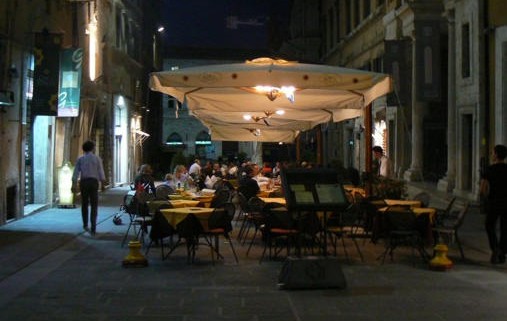
[Above and below: what Meredith missed, outside dining in Perugia at night]
1. Point of our series
TMJK’s core focus has long been upon “What happened at 7 Via della Pergola, in Perugia, on the night of November 1-2, 2007?”
Over the last 4+ years, more than 20 TJMK posts, with more than 400 comments, have addressed the subject of possible scenarios and timelines for those events. They represent a lot of thought and many are worth reading if you haven’t come across them before.
This post is the second in a series that will reappraise the more probable speculations, using the current state of our information. The first post was four weeks ago.
Reader comments in response to Part 1 amply reflect readers’ interest in exploring the various “˜open Questions’ referred-to, and how efforts to make Knox and Sollecito confront the true answers are obfuscated by their falsehoods.
The Truth of the actions of Knox and Sollecito on November 1st & 2nd, 2007, is so precious to them that they attend that Truth with a “˜Bodyguard of Lies’, to borrow Winston Churchill’s famous WW11 dictum. They even further obfuscate the answers to our questions by selectively employing a Bodyguard of Actual Truths.
The aim of their broken drain-pipe under the sink story (see previous post) was to persuade investigators, and everyone else:
1. That there was a broken drain-pipe under the sink (Massei Translation p.67), and
2. That the alleged water-leak occurred BEFORE the murder.
Their obfuscations include:
1. The omission of references to incriminating truths, e.g. omission of references to the hammer-toe on RS’s right-foot, one of his most incriminating physical attributes (see representative image of a right-foot hammer-toe below), and
2. The inclusion of “Half” truths, and
3. The inclusion of references to non-incriminating truths.
2. Integrated timing of phone events
This post is an integrated comparison of the timing of the phone-events byy coordinated universal time, merging Massei’s sections on Amanda Knox [AKP], and Meredith Kercher [MKP], as well as that of Rafaelle Sollecito [RSP].
[For the day of 31.10.07 it was shown that Meredith’s mobile phone with service provider Vodafone 348-4673711 sent an SMS at 18:27:50 hours using the cell at Piazza Lupattelli sector 7. (this signal is received in Via della Pergola 7.)
The same number received an SMS at 18:29:05 hours (this exchange of messages took place with the number 388-8921724) connecting to the same cell.
[RSP]: − on 31.10.07 Raffaele received *a call+ from the father’s fixed line (No. 080-3958602) at 22:14 for 44 seconds.
With respect to Sollecito’s mobile phone 340-3574303, attention was paid to the entire day of 1.11.07 with the following results]
Which help establish a less-suspicious baseline for comparison with later, more-suspicious results.
[RSP]− 00:00:39 an outgoing call, just after midnight
The phone traffic with regard to the day of 1.11.07 was reconstructed in the following terms (cfr. statement of Assistant Stefano Sisani at the hearing of 20.3.09).
AKP− 00:41:49 hours: outgoing phone call of 20 seconds, to a number whose holder was not identified
RSP− on 1.11.07 *he+ called the father’s house at 00:02:41 for 262 seconds
AKP− 00:57:20: Amanda’s mobile phone sent an SMS, using the cell on Via dell’Aquila 5-Torre dell’Acquedotto sector 3 (which does not provide coverage to Sollecito’s house, since it pertains to Via Ulisse Rocchi, Piazza Cavallotti, etc. and therefore at the heart of Perugia’s historic center). This consisted of the SMS which the young woman exchanged with Raffaele at the end of the Halloween evening to arrange meeting up with her boyfriend and be accompanied home
RSP− 00:57 an incoming SMS 319
AKP− 1:04:58: Amanda’s mobile phone received *a call+ for 53 seconds from the number 075/9660789, located in Piazza Danti 26
RSP− 14:25 an incoming call which lasted 58 seconds
RSP− 16:50 an incoming call, coming from the mobile phone of the father, lasting 214 sec.
RSP− 16:56 another call from the father (64 sec.)
AKP− 20:18:12: Amanda receives the SMS sent to her by Patrick Lumumba, which let her off from having to go to work at the “šLe Chic”› pub on the evening of 1 November. At the time of reception the phone connected to the cell on Via dell’Aquila 5-Torre dell’Acquedotto sector 3, whose signal does not reach Raffaele Sollecito’s house. The young woman was therefore far [i.e. absent] from Corso Garibaldi 30 when the SMS reached her, as she was walking in an area which was shown to be served by the Via dell’Aquila 5-Torre dell’Acquedotto sector 3 cell. This point of her route could correspond to Via U. Rocchi, to Piazza Cavallotti, to Piazza IV Novembre, bearing in mind that Lumumba’s pub is located in Via Alessi, and that Amanda Knox would have had to travel along the above-mentioned roads and the piazza in order to reach the pub
AKP− 20.35.48 Amanda sent an SMS in reply to Patrick, at No. 338-7195723; the message was sent when the young woman’s mobile phone was in Corso Garibaldi 30 or in the immediate neighbourhood. The cell used, in fact, was that of Via Berardi sector 7 − no other [use] was shown for the day of 1.11.07, noting that Amanda declared during hearings that she had switched her mobile phone off once she had returned 323 to Raffaele’s house, since she was more than happy she did not have to go to work and could spend the evening with her boyfriend.]
Knox may also have been LESS than happy that Lumumba preferred Meredith instead of Knox as an employee. This was humiliating-enough to Knox for Knox to decide that the time to cut Meredith down-to-size was now.
[RSP− 20:42:56 call from the father (221 seconds: this is the conversation which Dr. F. Sollecito referred to, made at the end of the film he had just seen in the cinema, which the father recommended to the son, at which point [it is said that] Raffaele informed his father of a problem with a broken drain-pipe under the sink in the kitchen”. ]
Massei Translation page 25: On “the evening of November 1, 2007 at around 10:00 pm, someone called and warned Elisabetta Lana not to use the toilet of her dwelling because it contained a bomb which could explode. Mrs. Lana immediately notified the police of this phone call; and they came to the house but did not find anything. Mrs. Lana and her husband were nonetheless asked to go to the Postal Police the next day to report said telephone call.”
MKP ““ 20:56 hours on 1 November 07, attempted call to Meredith’s mother’s home in England.
MKP ““ 21:58 hours on 1 November 07, attempted call to mobile phone’s answering service, voicemail “˜901’.
MKP ““ 22:00 hours on 1 November 07, dial to Meredith’s London bank “˜ABBEY’.
MKP ““ 22:13:29 hours (9 seconds) on 1 November 07, attempted internet connection. Connection consistent with being attempted from cottage, but inconsistent with being attempted from Mrs.Lana’s.]
Massei Translation, page 331, attributes the above 4 dialings to Meredith absent-mindedly playing with the mobile phone in her hand, and her phone may well have still been in her hand when her attackers surprised her.
Question: Was Meredith’s Phone still in the cottage at Via della Pergola at 22:13:29 hours on 1 November 07? Yes.
At about 22:30 hours Car broken-down nearby. Tow-Truck called-for.
At about 23:00 hours Tow-Truck arrives to load car.
At about 23:13 hours Tow-Truck leaves with loaded car.
[RSP- 23:41:11 RS’s father attempts phone-call but makes no oral contact. Father leaves message which is not received until 06:02:59 on 2.11.07.]
This 23:41:11 call was attempted during the very time-frame of the attack on Meredith, her murder, and the flight of her killers with her mobile telephones. Meredith’s Phone[s] were removed from her cottage by about Midnight, less than 20 minutes after this attempted call.
With regard to the day of 2.11.07:
[for 2.11.07 the first record is that of MKP - [0]0:10: 31, “when it has been established as an incontrovertible fact that Meredith’s English mobile phone was no longer in Via della Pergola, the mobile phone having received the contact under the coverage from Wind signal [cell] ..25622, which is incompatible with the cottage.”]
Question: Was Meredith’s Phone still in the cottage at Via della Pergola at 00:10: 31, 2.11.07? No!
Therefore Meredith’s English mobile phone had been removed from her cottage between 10.13.39 p.m. on 1.11.07 (more likely 11.13 p.m. when tow-truck departed) and 0:10:31 on 2:11:07; about 10 ½ minutes after midnight ““ say Meredith’s Phone[s] Removed By About Midnight, allowing for the time-elapse before being dumped near Mrs. Lana’s place. (Hellmann obfuscated this time-span on page 14 of his report, implying it to be more than 10 hours after midnight rather than about 10 ½ minutes after midnight.)
At some time before Meredith’s attackers fled, they had seized her mobile telephones, probably near the beginning of the attack, having started their attack with a pre-emptive strike to intimidate Meredith, remove all hope, surround her, display knives, seal all possible escape-routes, and remove any possibility of phone-calling for help.
Immediately after Meredith’s scream her attackers had silenced her with the fatal stabbing, and then fled immediately.
They fled with her already-seized but still switched-on mobile telephones, probably without locking anything, including Meredith’s door.
Their over-riding and 1st imperative was not-to-be-caught-at-the-crime-scene.
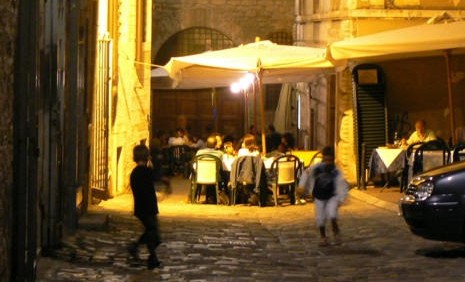
Having abruptly fled the crime-scene their 2nd imperative was not-to-be-caught-in-possession-of-Meredith’s-telephones.
Avoid Police!
Just seeing police could panic the killers into instant dumping of the telephones, without even needing to know why the police were where the police were (There is no need to invoke any awareness by the phone-dumper[s] of the reason the Police were near Mrs. Lana’s place - the hoax-call.). So if the killers saw flashing police-lights, or any other sign of police near Mrs. Lana’s place, that sign could be enough to explain panic phone-dumping - then and there (not considering whether the phones were switched-on or switched-off).
In “Darkness Descending” page 13, it states:
Mrs. Lana’s backyard overlooks a steep slope that falls sharply into the valley below. It is heavily overgrown with trees and bushes, an ideal place to dispose of evidence. If the phones had fallen just a few yards further, they would certainly have gone over the edge of the cliff, down into a 50m gully, straight into a thick scrub of nettles, and probably been lost forever”¦.
In “Death in Perugia” Follain states (Book page 62; Kindle Locations 343-6), apparently as his opinion re Lana’s daughter finding Meredith’s English phone: “It was hidden in some bushes, and she would never have found it if it hadn’t started ringing.”,
Having accomplished this 2nd imperative, Meredith’s killers paused to attend to their 3rd imperative: re-model the crime-scene, minimising the evidences of their identities, cleaning-up the evidences that it was “˜an inside job’, and simulating the appearances that it was “˜an outside job’.
One should bear in mind that these killers should have still been overwhelmed by their having actually committed a crime beyond their wildest imaginings.
Their panic impaired their thinking, and their ignorance, immaturity, inexperience, lack of technical resources and their arrogance precluded their selecting deceptions more effective against knowledgeable, experienced professional crime-investigators with a large fund of resources. They probably think that throwing the stone from inside Filomena’s room was a brilliant deception.
They wish it had never happened.
They wish they could make it unhappen (Hellmann/Zanetti got close to fulfilling this wish, but got themselves unhappened by Cassation)
They wish they could prevent the discovery of Meredith’s murder.
They cannot prevent the discovery of Meredith’s murder.
They may be able to postpone its discovery, but not longer than the inevitable return of the cottage-mates, later that day.
They believe that the person who “˜discovers’ a murder may become 1st-suspect.
They may be able to manouevre others-than-themselves into being the ones that make the discovery ““ quite a wily aim.
It is beyond reasonable doubt that
1. Meredith’s killers seized her mobile telephones, and that
2. Her killers did not switch-off these mobile telephones, and that.
3. Her killers threw the telephones into an apparent ravine, landing in Mrs.Lana’s garden, and that
4. This phone-dump was accomplished before 00:10: 31, 2.11.07, and that
5. Amanda Knox caused:
- i. the English phone to ring at 12:07:12 (16 seconds) and be discovered by Mrs.Lana’s daughter only because it rang , and
ii. the other phone, registered to Filomena Romanelli, to ring, very briefly, at 12:11:02 (3 seconds) and,
iii. the English phone to ring again, also very briefly, at 12:11:54 (4 seconds), after being brought into Mrs.Lana’s house.
6. Sollecito had more than 5 days, from about 11.30 pm on November 1st, 2007 until November 6, 2007, to remove from the killing-knife the traces of Meredith’s DNA.
In the opinion of the Court of Assizes (Massei Translation p.325), Amanda Knox’s call to Meredith’s phone was
...the first indispensible step before putting the [348] planned staging into action. The lack of a reply, since the poor girl was obviously already dead, gave a reason for reassurance about the fact that the young woman’s phone had not somehow been retrieved, [and] was therefore safe in the spot where it had been thrown, which, according to the expectations [in the minds] of the murderers was a precipice or some other inaccessible spot, rather than in the garden of a villa located barely outside the city, where the vegetation concealed it from view.
A plausible alternative opinion is that Knox’s calls to the obviously already dead Meredith were an obfuscatory stab to simulate what Knox imagined an innocent person would do.
Knox may well have expected that she was safe from phone-discovery, but these calls turned out to be the very instrument of a phone-discovery.
Had Knox not made these obfuscatory stabs, in the time-frame she made them Meredith’s phone would not have rung when it did ring and would therefore not have been discovered by Mrs, Lana’s daughter when she did discover it.
For the day of 2.11.07, when Meredith was already dead, the traffic registered for the Vodafone number was shown to be the following:
[MKS ““ 00:10:31; duration and caller unspecified, but Wind signal [cell] incompatible with cottage, but compatible with Mrs. Lana’s place.
Therefore, Meredith’s mobile cell-phone had already been taken away from the cottage by her killers. It is not possible to determine from this phone-record whether the phone was switched on or off, but this phone was discovered at Mrs. Lana’s place because it was ringing, and therefore was “on”.
MKS− 12:11:02 (duration of 3 seconds): Amanda’s phone call reached the phone and was diverted to the answering service. The Vodafone cell used by Meredith’s service provider was situated in Strada Vicinale S. Maria della Collina sector 1.
AKP− 12:11:54 (4 seconds): another call is made towards Meredith’s English mobile phone number (the cell used is the one in Via dell’Aquila 5-Torre dell’Acquedotto sector 3, thus compatible with Sollecito’s house)
RSP− 06:02:59 Raffaele Sollecito received the SMS from his father wishing
Raffaelle a good night; from the evidence of the mobile phone record printouts of Dr. Francesco Sollecito, it was shown that the sending of the message occurred at, as has been said, 23:41:11 of 1.11.07. This was the last SMS sent from that mobile phone during the whole day of 1.11.07]
3+ Hours after receiving his father’s message from 23:41:11 of 1.11.07:
[RSP− 09:24 Raffaele Sollecito received a phone call from his father lasting 248 seconds]
At this time RS’s consiousness would be dominated by his guilty knowledge, and probably far-advanced in the accomplishment of the 3rd imperative.
Did RS and father spend 4+ minutes discussing the weather?
This is the first father/son opportunity to formulate the two-pronged water-leak story.
Although AK had already been to the hardware store 2 hours before, they may well not have known the potential DNA problems with the knife, the need to scrub it vigorously, to clean-out, and repair the drain-pipes under the sink, and the need to return the knife to RS’s kitchen drawer.
As it turned-out, Sollecito had more than 5 days, from about 11.30 pm on November 1st, 2007 until November 6, 2007, to remove from the killing-knife the traces of Meredith’s DNA.
They probably did not know that incriminating stains could be invisible, but can be revealed byLuminol.
RSP− 09:29 another call was received lasting 38 seconds
RSP− 09:30 (duration unspecified?) the father called Raffaele; the call connected to the Vial Belardi sector 7 cell.(the best server cell for Corso Garibaldi 30).]
These two calls were probably spent dotting “˜i’s, crossing “˜t’s, and exchanging options, such as enlisting sister Vanessa’s skills and contacts.
Another 2+ Hours later:
[AKP− 12:07:12 (duration of 16 seconds) Amanda calls the English phone number 00447841131571 belonging to Meredith Kercher. The mobile phone connects to the cell at [346] Via dell’Aquila 5-Torre dell’Acquedotto sector 9 (the signal from this cell is picked up at Sollecito’s house)
AKP− 12.08.44 (lasted 68 seconds) Amanda calls Romanelli Filomena on number 347-1073006; the mobile phone connects to the Via dell’Aquila 5-Torre dell’Acquedotto sector 3 cell (which covers Sollecito’s house)
Discovery will be inevitable when Filomena eventuallyarrives-back at the cottage.
AK/RS have accepted that they have to “˜stand-pat’ with their efforts so-far to accomplish their 3rd imperative.
Amanda did not say a word in this phone-call to Filomena about Amanda’s phone call to Meredith, thereby withholding information that should have led Amanda to initiate discovery of Meredith’s body, and help Amanda to manouevre someone other than Amanda into being the one who “˜discovers’ Meredith’s body.
AKP− 12:11:02 (3 seconds) the Vodafone number 348-4673711 belonging to Meredith (this is the one [i.e. SIM card] registered to Romanelli Filomena) is called and its answering service is activated (cell used: Via dell’Aquila 5-Torre dell’Acquedotto sector3)
MKS: For the day of 2.11.07, when Meredith was already dead, the traffic registered for the Vodafone number was shown to be the following:
− 12:11:02 (duration of 3 seconds): Amanda’s phone call reached the phone and was diverted to the answering service. The Vodafone cell used by Meredith’s service provider was situated in Strada Vicinale S. Maria della Collina sector 1.
AKP− 12:11:54 (4 seconds): another call is made towards Meredith’s English mobile phone number (the cell used is the one in Via dell’Aquila 5-Torre dell’Acquedotto sector 3, thus compatible with Sollecito’s house)
AKP− 12:12:35 (lasting 36 seconds) Romanelli Filomena calls Amanda Knox (No. 348-4673590); Amanda receives the call connecting to the cell on Via dell’Aquila 5-Torre dell’Acquedotto sector 3 (still at Raffaele’s house)
AKP− 12:20:44 (lasting 65 seconds) Romanelli F. calls Amanda, who receives the call connecting to the cell in Via dell’Aquila 5-Torre dell’Acquedotto sector 9 (good for Corso Garibaldi 30)
AKP− 12:34:56 (48 seconds): Filomena calls Amanda who receives it from the cottage on Via della Pergola 7 (the cell used is that on Piazza Lupattelli sector 7. As mentioned, Raffaele also used the same cell when he called the service centre at 12:35 hours to recharge [the credit of] his mobile phone)
RSP− 12:35: Raffaele’s mobile phone contacted a service centre for a phone [credit] recharge (the cell used was that of Piazza Lupattelli sector 7, which gives coverage to the little house on Via della Pergola 7. The signal in question does not reach Corso Garibaldi 30, which instead is served by the signal from Piazza Lupattelli sector 8)
RSP− 12:38: Vodafone sent a message of confirmation of phone [credit] recharge (Piazza Lupattelli sector 7 cell, good for Via della Pergola 7)
RSP− 12:40: incoming call from the father’s mobile phone (lasting 67 seconds; connection through Piazza Lupattelli sector 7 cell, compatible with the Sollecito’s presence near the little house)]
Do RS and father exchange caveats?
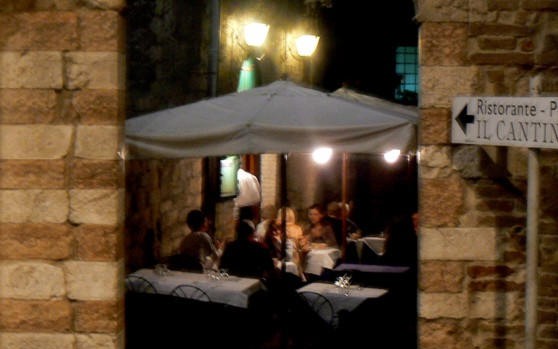
[AKP− 12:47:23 (duration of 88 seconds): Amanda calls the American (USA) number 00120069326457, using the cell on Piazza Lupatetlli sector 7; the phone call takes place prior to the one which, at 12.51.40, Raffaele Sollecito will make to “š112”›, connecting to the cell on Via dell’Aquila 5-Torre dell’Acquedotto sector 1, which gives coverage to Via della Pergola 7]
In “Waiting To Be Heard” Knox can hardly deny having made this 1st call, acknowledges making the call, and purports, now, to recall its substance, providing the reader with her version of what was said.
[AKP− 13:24:18 (duration of 162 seconds): Amanda calls the same American number which corresponds to the home of her mother, Mrs Edda Mellas, using the same cell. It is obvious that the young woman is inside the cottage, where by this point, several minutes earlier, the Postal Police had shown up, [347] represented by Inspector Battistelli and Assistant Marzi, who were engaged in the task of tracking down Filomena Romanelli, who was the owner of the Vodafone phonecard contained in the mobile phone found earlier in the garden of the villa on Via Sperandio]
In “Waiting To Be Heard” Knox can hardly deny having made this 2nd call either, she acknowledges making the call, and provides the reader with her current version of what was said.
[RSP− 12:50:34 outgoing call directed at mobile phone 347-1323774 belonging to Vanessa Sollecito, sister of the defendant; duration 39 seconds. Connection to Piazza Lupattelli sector 7 cell 320
RSP− 12:51:40 Raffaele Sollecito called “š112”› to inform the Carabinieri of the presumed theft in Romanelli’s room (duration 169 seconds; connection to Via dell’Aquila 5-Torre dell’Acquedotto sector 1 cell, which covers Via della Pergola 7)
RSP− 12:54: a second call by Raffaele to “š112”› (57 sec.; connection to Piazza Lupattelli sector 7 cell)
MKS− 13:17:10 (lasting 1 second): the cell used was located in the same place, sector 7
AKP− 13:27:32 (duration of 26 seconds): Amanda calls the American number 0012069319350, still using the cell at Piazza Lupattelli sector 7.
AKP− 13:29:00 (duration of 296 seconds) Amanda receives [a call] from No. 075/54247561 (Piazza Lupattelli sector 7 cell)
RSP− 13:40:12: incoming call from the father (94 sec.; Via dell’Aquila 5-Torre dell’Acquedotto sector 1 cell)]
AKP− ?13:48:33 (1 second): this is an attempted call to her mother’s number
““ see below at 13:58:33
AKP− 13:58:33 (1 second): this is an attempted call to her mother’s number
The above item is a faithful translation from the Massei Motivazione section on Amanda Knox’s mobile phone traffic, but is listed out-of-time-sequence; the assigned-time is probably a “˜typo’ ““ “13:48:33” is much more likely correct.
[RSP− 14:33: the father called for 21 seconds (as above)]
Do RS and father exchange more caveats?
[AKP− 14:46:14 (102 seconds) Amanda receives a call from the German number 494154794034, most likely belonging to her aunt Doroty Craft
MKS− 15:13:43 (5 seconds) cell not indicated.
AKP− 15:31:51 (1 second): Amanda receives an SMS sent from the number 389/1531078; at this point the cell being used is the one on Via Cappuccinelli 5/A sector 2, where the Questura [police headquarters] is located
In the hours that followed the [mobile phone record] printouts show that the answering service of Amanda’s number 348-4673590 was activated due to a lack of signal coverage.]
Massei Translation p.324:
Finally, the analyses of the [phone record] printouts highlight that the first phone call made by Amanda on the day of 2 November was to Meredith Kercher’s English number.
The American student called her English flatmate even before contacting Romanelli Filomena to whom she intended to express, as she testified in court, her fears about the strange things she had seen in the cottage, which she had returned to at about 11 o’clock in order to shower in preparation for the excursion to Gubbio which she and Raffaele had planned.
It is strange that Amanda did not say a word to Filomena about the phone call to their flatmate, when the call, not having been answered, would normally have caused anxiety and posed some questions as to why Meredith did not answer the phone at such an advanced hour of the day.
[RSP− 17:01: the father called for 164 seconds; cell used is that of Via Cappucinelli 5/A sector 2, corresponding to the location of the Perugia Police Station
RSP− 17:42: the father called for 97 seconds (as above).
With regard to Raffaele Sollecito’s landline home phone (No. 075-9660789)
The above 2 calls presumably covered final agreements on the Father/son stories.
For the entire day of 1 November and then of 2 November, Raffaele Sollecito’s fixed line was not affected by any calls, either incoming or outgoing.]
This finishes the merged listings of the Massei sections on AKP, MKP, and RSP, using the UPC telephone traffic, reappraising the more probable scenarios surrounding what happened at 7 Via della Pergola, in Perugia on the night of November 1-2, 2007.
Readers are invited to make their own suggestions on probable scenarios, here below or in email.
Monday, February 18, 2013
Raffaele Sollecito Now Under Formal Investigation For New Crimes Apparently Unprecedented
Posted by Our Main Posters
Breaking news. The Chief Prosecutor for Tuscany Dr Quattrocchi (above and below) has taken this investigation of Sollecito behind the scenes. Dr Quattrocchi is actually under no compulsion to make any of the Perugia and Rome complaints public before his investigation is complete. He has ordered all documents removed from the public domain. This is specifically to give the defense and their PR no advantage, and to make sure those others in Perugia who are going to complain about being defamed do so without harm.
Overview
This is a contempt of court case as court officials have been impugned. This is Wikipedia’s definition of “contempt of court” under US and UK common law.
Contempt of court is a court order which in the context of a court trial or hearing, declares a person or organization to have disobeyed or been disrespectful of the court’s authority.
Often referred to simply as “contempt,” such as a person “held in contempt,” it is the judge’s strongest power to impose sanctions for acts which disrupt the court’s normal process.
A finding of contempt of court may result from a failure to obey a lawful order of a court, showing disrespect for the judge, disruption of the proceedings through poor behaviour, or publication of material deemed likely to jeopardize a fair trial.
A judge may impose sanctions such as a fine or jail for someone found guilty of contempt of court.
We may now find out much more about the equivalent under Italian law.
When Raffaele Sollecito and Amanda Knox were released at the end of 2011, the prosecution filed a Supreme Court appeal within the allotted period. This automatically meant that Sollecito and Knox still stood accused of crimes until the Supreme Court finally signs off.
Typically Italian defendants in such a legal status get good legal advice, on the lines of “Shut up and keep your heads down. We need to be the only ones doing the talking here.”
Here such advice may or may not have been forthcoming, but the public record strongly suggests it was not. In fact Sollecios entire legal team is credited by both himelf and his shadow writer Andrew Gumbel with helping. This is what Gumbel wrote in his Acknowledgments:
Donatella Donati in Luca Maori’s office gave up many hours to make the official documentation available and to present it all in a cogent order. She’s a largely unsung hero in this story and deserves recognition for her extraordinary efforts on Raffaele’s behalf. Giulia Bongiorno, Luca Maori, and Tiziano Tedeschi answered questions and made comments on parts of the manuscript.
In the same Acknowledgments Sollecito credits the following.
I was lucky to have a crack legal team who showed their devotion to the truth and, in some cases, did not even request payment. The team of lawyers and consultants included Adriano Tagliabracci, Francesco Vinci, Bruno Pellero, Francesco Introna, Giulia Bongiorno, Maurizio Parisi, Daniela Rocchi, Luca Maori, Donatella Donati, Marco Brusco, Aldo Poggioni, Delfo Berretti, Tiziano Tedeschi, and Antonio D’Ambrosio.
Interestingly, Luca Maori has already left Sollecio’s legal team, and all eyes are now on Giulia Bongiorno. Buy plenty of popcorn. Lawsuits could fly between lawyers and family.
Since the end of 2011 Curt Knox’s forces seem to have have gone full steam ahead with their own vilifications of the Italian prosecutors, police, judges, and witnesses - in fact almost anyone who had any role in 2009 in finding them guilty, or came to believe that was a fair finding. Ourselves included.
In late 2012 Curt Knox apparently invited all the most fervent of these attackers to Seattle, including Frank Sforza and Bruce Fischer, as some sort of reward for their legally very ill-advised campaign. Buy plenty more popcorn. Lawsuits could fly here as well.
Raffele Sollecito’s forces in Italy had been a lot more restrained.
But at a stroke, the shrillness of Raffaele Sollecito leapfrogged that of Amanda Knox’s forces, with the publication of his book Honor Bound by Simon and Schuster in English in the UK and US last September,
INSTANTLY the book became notorious in Italy, because excerpts were read out by an Italian reporter in New York on the national television show Porta a Porta. Raffele Sollecito’s father Francesco was on that show, and he was increasingly forced to admit a key claim in the book was invented. It simply never happened. His son made it up.
The false claim by his son that Francesco was made to repudiate - it reappears over many pages - concerned a claimed deal engineered by his family and offered by the prosecution to Sollecito.
The deal he claimed was to roll over on Amanda Knox, and if Sollecito did so, he would be home free.
Following the Porta a Porta show, the book (obtainable on UK Amazon, where many false claims are repeated in the reviews) began to make its rounds in Italy. It took some time before many official parties accused of crimes by Sollecito obtained copies and started to explore their own legal possibilities. They are apparently still far from finished.
At the end of last week, the Chief Prosecutor for Tuscany Giuseppe Quattrocchi received the first official request from Perugia, which is to investigate 12 very serious claims in the book against the prosecution and the legal institutions of Italy. The complaint nominates a number of witnesses.
The Prosecution office of Florence now has a maximum of six months to investigate whether there is a case against Sollecito and other named parties. If so, they will steer it through the hoops of the Italian process.
The potential ripple effects of this appear to us to stretch on and on. They could come to engulf both legal teams (credited in the book with helping) and all of the PR for both defendants. Sollecito’s publisher and shadow writer are specifically named in the complaint
If Amanda Knox is not let off the hook by the Italian Supreme Court late in March (the outcome we consider most likely, given the great strength of the appeal) the smart way for Knox to go in light of this could be to junk all her websites, her book, and her interviews, and throw her supporters under the bus. Plus maybe get smarter lawyers - the aggressive and inexperienced Dalla Vedova does her no favors.
Keeping Amanda Knox’s head out of this deadly new line of fire may be very late - but maybe better late than never.
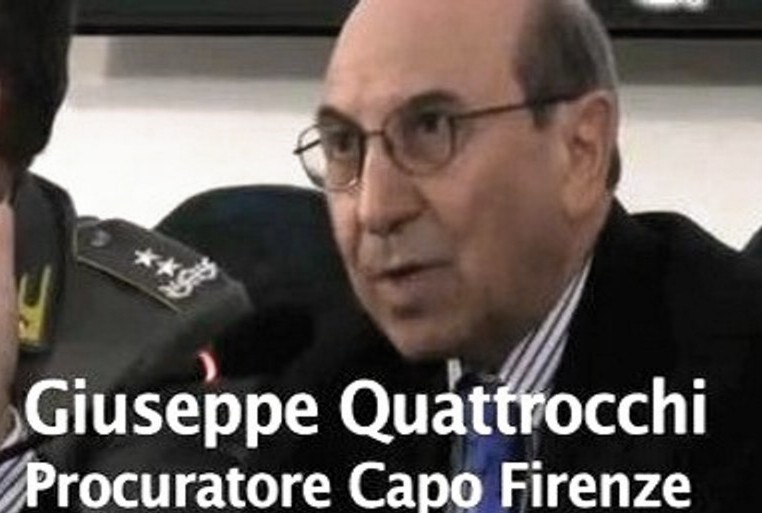
Friday, July 27, 2012
Heads-Up To The Amanda Knox Forces: A Case Showing How Closely The US and Italian FBIs Co-operate
Posted by Peter Quennell
Meet Doctor Mark Weinberger.
That report about his arrest in Italy was broadcast in 2009. We last posted on him here.
Weinberger was apparently a wildly successful doctor who ran a sinus clinic in Indiana and lived a wildly affluent lifestyle a few milers north outside Chicago. In 2004 he disappeared off his large yacht which was then anchored at a Greek marina, and for six years his (very impressive) wife Michelle presumed he was dead.
In the meantime she had found out that he had actually been running a huge fraud, scamming health insurance and the US government via false billing and unnecessary surgery (often botched) for many millions. And that far from being left comfortably off, she was financially wiped out.
In 2006 in absentia she divorced Weinberger and started over.
In 2009 Weinberger was captured in the Alps by the Italian equivalent of the FBI and returned to the United States as soon as his extradition was requested. In perhaps 99 percent of all US-Italian extradition cases, the fugitives are handed over by both governments very promptly. This sure wasn’t any exception.
Weinberger began to lose the first of numerous civil suits a year ago, and on wednesday he pleaded guilty to 22 criminal charges in federal court.
His prison term is set at ten years.
One moral of the tale apparently still not learned by Steve Moore and Bruce Fischer and their hapless ship of fools, so desperate for approbation, is this: much or most of the time it is the fine Italian equivalent of the FBI that they are misrepresenting and defaming.
In the past two weeks alone, we have seen new ramblings by Saul Kassin and Nigel Scott (engineered by Bruce Fischer) that to any informed lawyer are quite crazy. Kassin and Scott clearly didnt have the slightest idea WHO they were defaming or accusing of crimes.
Or how much more determined thier defaming makes the Italian FBI and other law enforcement agencies and the courts to give Amanda Knox (or Curt Knox or Edda Mellas) no special breaks.
The daffy Steve Moore first introduced this confusion way back here. And of course Bruce Fischer, Curt Knox’s hotheaded chief hatchet man, sustains it up to this day.
Eighteen months ago, Chris Mellas (whose business in Seattle is doing well) sensibly recommended from Perugia that the Knox campaign should finally acquire some cool heads and some REAL experts, and toss the trouble-making grand-standers they had acquired over the side.
Perhaps predictably, Curt Knox (whose business in Seattle is doing badly) reacted red-faced and steaming, and shot this seemingly quite smart idea down. So the abrasive, misleading, very amateur campaign goes on.
***
Added. We are now told that Frank Sforza and David Anderson are in Seattle, and Sollecito will be there soon, to actually jack up the level of defaming in the RS and AK “we were the victims” books being written.
Wow. THAT is Curt Knox’s end-game?l He ran that one past Chris Mellas? It seems universally believed in officialdom in Rome and Perugia that Curt Knox KNEW all along that Amanda did it. Apparently with good evidence.
What will he do if they charge him?
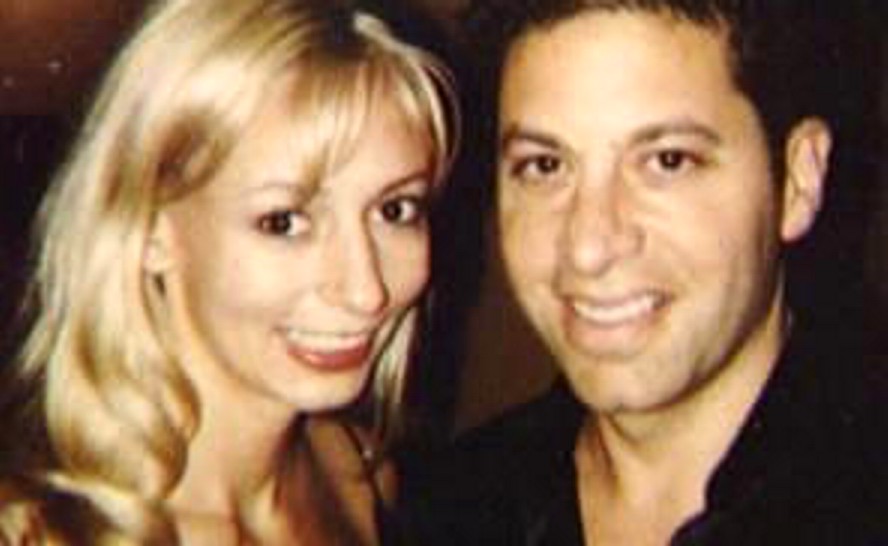
Tuesday, June 26, 2012
Italian Police Long Known As Among Europe’s Coolest, Now Also Being Remarked Upon As…
Posted by Peter Quennell
It’s tough right now for Italian cops, going up against the rioting crowds and the illegal immigrants and the three mafias. But with their sustained pressure the mafias are fading, and the riots and immigrants may dwindle soon if and when light appears at the end of the economic tunnel.
And those images are not what Italian police are best known for.
Above all else, they are cool. They officially work hard at being cool and high-profile and rather colorful, which is perhaps one reason why the Italian prison population is so very low. Their regular uniforms and their ceremonial uniforms tend to be eye-catching, and sometimes resplendent, and unless you’re Mr Berlusconi, their manner tends toward firm but agreeable, and sometimes quite funny. .
One can be doing 100 mph on an autostrada and a car will come by at 140 mph, with a police car on its tail which can exceed 200 mph. The second to last image below (above the… enough said) is of a Bugatti Veyron, which even in standard mode is powered by an engine of 1000 horsepower and has been clocked at close to 250 mph. (It also costs close to $2 million to private buyers.)
Now here is a report by John Hopper in the UK Guardian on the Italian police’s frequent warm side, and there are similar tales about the polizei on quite a few English-language and Italian blogs.
The financial crisis in Europe may have brought out the worst in certain bankers, but it seems to be bringing out the best in Italy’s police.
On Tuesday, and for the second time in less than a month, officers called to deal with a shoplifter were reported to have taken pity on the alleged thief and paid for the goods out of their own pockets.
The latest case arose when staff at a supermarket on the outskirts of Siena, in Tuscany, alerted police to a suspected robbery. The officers found a 27-year-old Egyptian and his 19-year-old brother who had apparently failed to pay for goods they had removed from the shop.
The police established that the older of the two was unemployed and had a wife and two children. Along with some pasta, he and his brother were found to have taken only milk, nappies and baby food. At this point, according to Corriere Fiorentino, the officers opened their wallets and paid the bill.
A similar gesture prompted a round of applause from shoppers at a supermarket in Milan after a 76-year-old pensioner, identified only as Angela, was found to have passed through the checkout without paying for a box of Tic Tac sweets worth 60p.
Sergeant Arturo Scungio said he and his patrol partner had caught up with the suspect near the shop. “She was trembling like a leaf and was clearly frightened by the uniform. From the way she was dressed, I realised she was not well off, that she was one of those who have difficulty making it to the end of the month. I told her what the law was and then I asked her how much pension she received.”
The old lady said that she was on €320 (£255) a month, adding: “I’ve always paid my taxes.” Scungio said that by the time they returned to the supermarket checkout, she was in tears.
The manager told them he did not intend to press charges. “I opened my wallet and paid the 78 cents owed for the Tic Tacs,” Scungio said.
Those humorless sad sacks who have attached themselves to Amanda Knox like leeches… Pity they’re so blinded to Italy’s rather cool reality.
